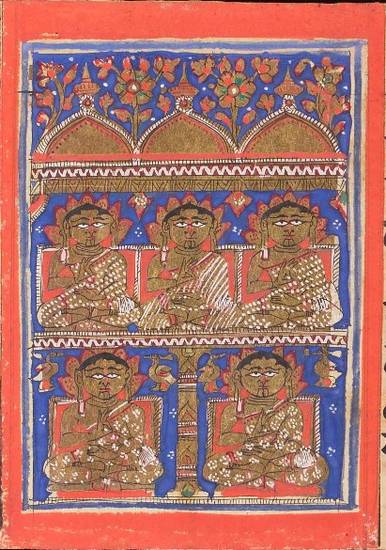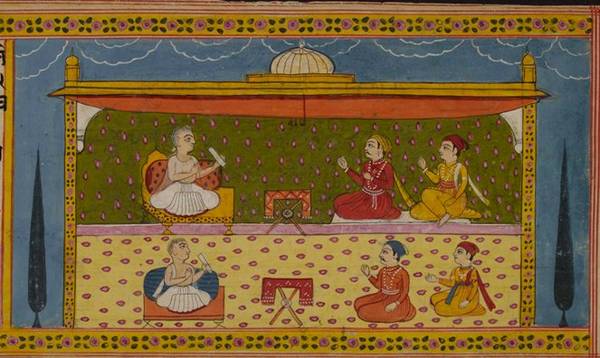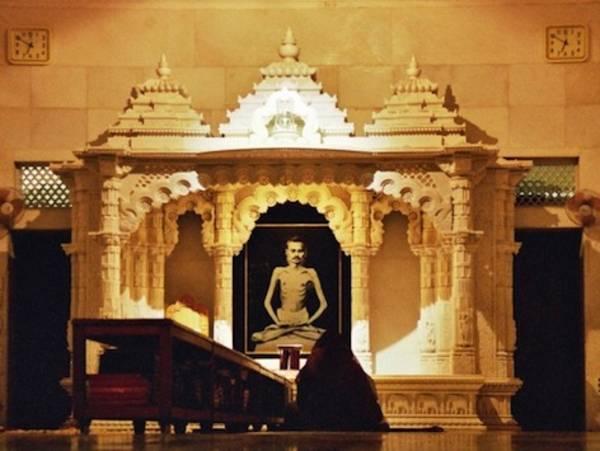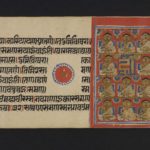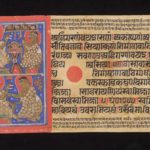Article: Sects
Just as other religions have different groups within them, so Jainism has several sects or traditions, which were born as the religion developed. At the beginning of the Common Era, the followers of the Jinas separated into two groups, focusing on practices and beliefs surrounding mendicants. These groups gradually developed distinct doctrines and histories, boasting different canons of sacred writings and significant figures. These remain the main divisions or sects of Jainism.
The Digambara and Śvetāmbara sects each contain smaller subsects, which differ from the mother sect in various points of doctrine and practice. Though they may have fierce differences and disagreements over certain aspects of doctrine or practice, especially regarding the ownership of pilgrimage places, all the groups consider themselves Jains.
Very broadly, all lay and mendicant Jains can be grouped in sects. Monks and nuns are affiliated with various mendicant orders, which can be thought of as more or less a sect or subsect. For instance, a monk belongs to the Tapā-gaccha. For lay Jains, this is not really an accurate description, however. A lay man defines himself as a member of society, of a caste, who may view himself as a follower of mendicants who belong to a given order or sect.
Members of a given tradition claim identical spiritual affiliation. Historically, a mendicant order has mostly been at the root of a sect, attracting lay followers. However, some sects have grown up around a charismatic lay person. Some sects are now extinct while others have emerged in the 20th century.
This fading away of old sects and arising of new ones is the sign of a living faith, one which is not monolithic and inflexible. Changes within the Indian society where most Jains live or in the countries where they have settled have an impact on religious practice and thought. This is compounded by developments in the non-Jain religious landscape. However, promoters of ascetic ‘reforms’ – which may develop into a new sect – often present their ideas as returns to the original purity that has been challenged or lost in the course of time.
Terms
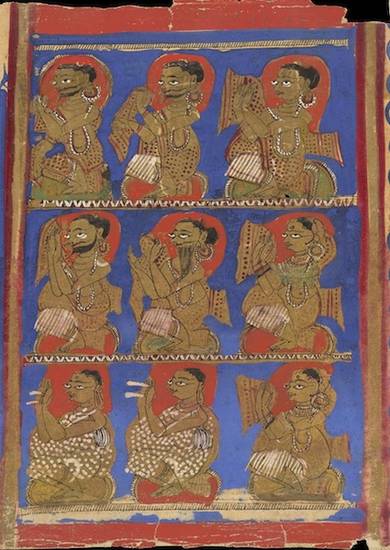
Fourfold community
Image by Wellcome Trust Library © Wellcome Library, London
The largest group with which a Jain can be associated is the ‘sect’. This concept can be described using various terms, some of which are broad synonyms while others suggest a slightly different meaning. The two principal traditions of Digambara and Śvetāmbara Jains use the following Sanskrit terms for the notion of a sect:
The broadest term is saṅgha. It can be used of the whole ‘fourfold community’, made up of monks, nuns, lay men and lay women. However, it can also describe the ‘monastic community’ – sādhu-saṅgha or muni-saṅgha.
Jains use the terms gaṇa or gaccha, both meaning ‘group’, for a ‘monastic order’. Most Śvetāmbara Jains also use gaccha to refer to the largest unit of association, often called the ‘sect’. It is part of the name of certain Śvetāmbara Mūrti-pūjak sects, such as the Añcala-gaccha and Kharatara-gaccha. The Śvetāmbara Sthānaka-vāsin use sampradāya instead.
Digambara Jains tend to use gaccha or gaṇa to describe their groupings.
Digambaras and Śvetāmbaras
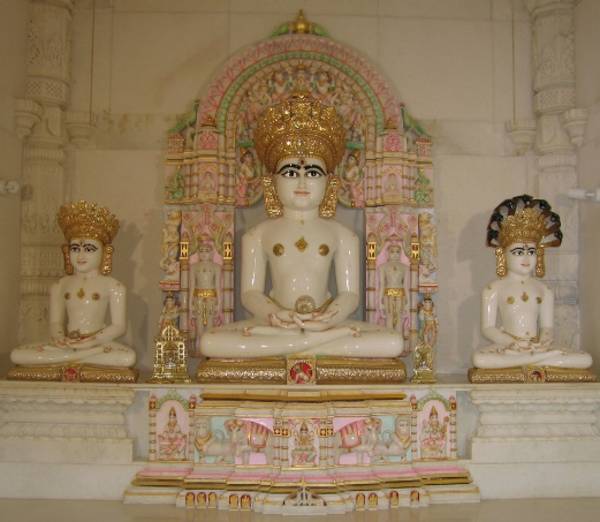
Śvetāmbara figures of Ṛṣabha, Māhavīra and Pārśva
Image by unknown © Oshwal Association of the UK (OAUK)
The major division within Jainism, between the Digambaras and Śvetāmbaras, is likely to have started early in the Common Era and is over 1500 years old. These two traditions or sects take their names from the appearance of their monks. One of the main areas of dispute that was instrumental in the split is that of holy writings. These two sects now recognise different canons of sacred texts.
Within these principal sects are several smaller traditions or subsects. These may be named for characteristic practices or beliefs or after their founder or inspiration. For some of these the chief point of contention, which was probably the seed of the break from the main sect, is that of image worship. The subsects can be classed as either iconic or aniconic and can belong in either of the main sects. The larger category is the iconic tradition, usually dubbed Mūrti-pūjaka – ‘image-worshipping’ in Sanskrit – which believes that images of the Jinas and other figures should be the focus of worship. The aniconic sects maintain that it is not proper to worship images.
Within the principal traditions, subsects often develop when a new mendicant order forms. Usually created by a charismatic monk and based on different interpretations of scriptures, these monastic orders may attract lay followers. The movement may then develop distinct doctrines and practices that lead it to be described as a new sect.
It can be hard to tease out the full picture of sectarian development, especially those that do not exist today. The biggest source of textual evidence is the records kept by the mendicant orders. For this reason it is particularly difficult to reconstruct the course of the Digambara tradition, which relies less on precedent and rule than the Śvetāmbaras.
Main differences
The monks of the Digambara tradition – ‘sky-clad’ in Sanskrit – go naked because they believe that all the Jinas and their male ascetic followers were nude as part of their vow of renunciation. This involves renouncing all worldly items, including clothing. Female Digambara ascetics wear white robes and thus, as technically spiritually advanced lay women, they are believed to be inferior to monks.
Both monks and nuns in the Śvetāmbara tradition – ‘white-clad’ in Sanskrit – wear white clothing.
The major differences between the two traditions are summarised in this table.
|
|
Digambara |
Śvetāmbara |
|---|---|---|
|
Monk – nothing |
white robes |
|
|
plus, for Mūrti-pūjak mendicants only:
|
|
|
Āgamas:
|
|
|
cannot achieve liberation |
can achieve liberation |
|
|
Sex of Jinas |
are all male |
|
|
Images of Jinas |
|
|
In the course of history, subsects or groups developed within both sects. They formed monastic lineages centring on the figures of successive monastic leaders. Records of such lineages – the paṭṭāvalis or gurv-āvalis – are available for several subsects. They represent valuable forms of official monastic history and chronology, and thus can shed light on the growth of the sect.
Digambara traditions
Today full-fledged Digambara mendicants – munis – are scarce. Continuing the ancient tradition of a senior monk’s attracting pupils, the monks tend to gather followers. These are usually junior monks, novices and lay people. Digambara mendicants ‘seem to have an especially weak sense of standard training, of a line of pupillary succession, or of allegiance to an order’ (Carrithers 1989: 230). Instead, there is greater emphasis on the charismatic leadership of individual mendicants who are able to influence the lay communities.
In the past the situation was probably similar in terms of the significance of individual leaders. However, when there were more Digambara mendicants it seems to have been much more complicated. Dundas (2002: 121) has rightly noted ‘the complexity of medieval Digambara ascetic organisation in which a plethora of sects and subsects, many of them totally obscure to us today, emerged on the basis of preceptorial association and geographical connection with particular regions and towns’.
This intricate picture of the Digambara tradition is increased by the fact that, besides monastic lineages, there are regional lineages of the bhaṭṭārakas. These are based on seats of power in particular places. The establishment of a bhaṭṭāraka in certain areas has contributed to the survival of Digambara Jainism.
Information on historical and contemporary monastic lineages is hard to come by. Early lineages seem to have faded, with the present Digambara monastic community tracing its origins to the late 19th and early 20th centuries. Of the six groups around at that time, only three are now present in contemporary India (Flügel 2006: 350). These are:
These statistics of Digambara mendicants are based on information on page 355 of Flügel 2006.
|
Year |
Males |
Females |
Total |
|---|---|---|---|
|
2000 |
453 |
365 |
818 |
|
2001 |
508 |
394 |
902 |
Śvetāmbara sectarian traditions
The main evidence for the origin of Śvetāmbara mendicant lineages is the Sthavirāvalī, which forms the second part of the Kalpa-sūtra, a holy text. It is meant to reflect the situation at the time of Mahāvīra, the 24th Jina. His direct disciples were the eleven gaṇa-dharas, who were the heads of nine mendicant groups – gaṇas. The difference in number comes from the fact that two groups were managed by two gaṇa-dharas at the same time.
The only one of Mahāvīra’s disciples who founded a monastic succession is Ārya Sudharman. All the later Śvetāmbara sectarian traditions claim descent from him except one, the Upakeśa-gaccha. This group claims descent from the 23rd Jina, Pārśvanātha or Lord Pārśva.
The Sthavirāvalī continues the list of successive teachers who claim a common mendicant ancestor. The last one mentioned is Devarddhi Kṣamāśramaṇa, the teacher who organised the writing down of the holy scriptures in the 5th century CE at Valabhī, in Gujarat.
On the other hand, later records concerned precisely with the writing down of the holy scriptures show that two distinct recitations existed. These were associated respectively with the towns of Mathurā and Valabhī. This means that there was some sort of division and disagreement between two schools even at this stage.
From the 11th to 12th century onwards, quite a number of subsects emerged. This ferment was probably linked to the issue of image worship, which became crucial in the late medieval period, causing a major split. The labels that are mostly used nowadays to distinguish among the subsects of Śvetāmbara Jains go back to this relatively late period. They are:
- Mūrti-pūjak
- Sthānaka-vāsin
- Terāpanthin.
Although there are key points of agreements among all the Śvetāmbara sectarian traditions, there are several areas of dispute.
The Śvetāmbara sects agree on the:
- authority of the Śvetāmbara canonical scriptures
- claims of monastic descent from Sudharman, except for the Upakeśa-gaccha
- white monastic robes of monks and nuns.
The main cause of the schisms is the correctness of worshipping images. The largest sect, the Mūrti-pūjaks, worship images whereas the Sthānaka-vāsin and Terāpanthin Jains do not. There are also other matters of disagreement, which have probably arisen over time partly as a way of distinguishing the sects from each other.
|
|
Mūrti-pūjak sect |
Sthānaka-vāsin sect |
Terāpanthin sect |
|---|---|---|---|
|
Number of authoritative canonical scriptures |
45 |
32 |
32 |
|
Worship of images |
yes |
no |
no |
|
Monastic equipment – staff |
yes |
no |
no |
|
Monastic equipment – broom handle |
short |
long |
long |
|
Monastic equipment – use of mouth-cloth |
worn at certain times |
worn permanently |
worn permanently |
|
Nuns’ status – access to canonical scriptures, to various levels |
yes |
yes |
yes |
|
no |
no |
yes |
Other areas where the sects differ relate to the daily liturgy and recitation of prayers and to the religious calendar.
Image worshippers
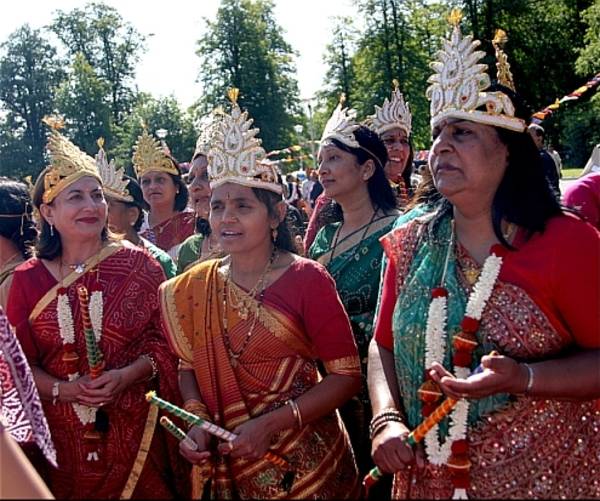
Celebrating the installation of an idol
Image by Chandu Shah © Chandu Shah
The largest sect is the Mūrti-pūjaka, which means ‘worshipper of images’ in Sanskrit, referring to images of the Jinas. Synonyms are the modern Indian words Derāvāsī – which literally means ‘staying in temples’ – and Mandir Mārgī – ‘temple-followers’. The Mūrti-pūjaks can be categorised into several subsects – gacchas:
- Tapā-gaccha
- Añcala-gaccha
- Kharatara-gaccha
- Pūrṇimā-gaccha
- Pārśvacandra-gaccha
- Vimala-gaccha
- Tristuti-gaccha.
Such terms have to be understood in contrast with the Sthānaka-vāsins, who reject image worship. This explains why these terms became common when the latter came into formal existence, between the 15th and 17th centuries.
Non-image worshippers
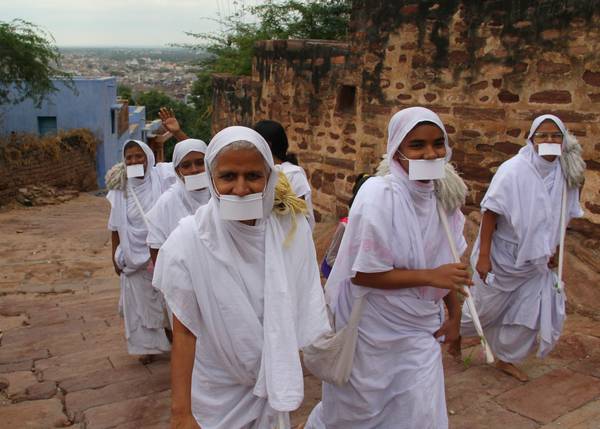
Śvetāmbara Sthānaka-vāsin or Terā-panthin nuns
Image by arjunstc – Arjun © CC BY-NC-ND 3.0
Developing from the lay tradition established by the lay man Lonkā Śāh in the 15th century, the Sthānaka-vāsins reject the worship of images. Instead of temples the centre of public worship is the mendicant dwelling-hall. Meaning ‘hall-dweller’ in Sanskrit, ‘Sthānaka-vāsin’ seems to have become a common term only in the early 20th century.
Founded by a Sthānaka-vāsin monk who left his order, the Terāpanthins also do not believe that image worship is correct. Ācārya Bhikṣu established it in the 19th century, along with 12 other monks. The sect gets its name from this fact, because the Hindi term terāpantha or terahpantha means either ‘your path’ or ‘path of 13’.
Lay traditions
In the course of history, a new sect has commonly been generated after a new mendicant order has developed. However, a number of traditions that have arisen among both Śvetāmbaras and Digambaras have been established among lay communities. Some of them were created by lay men who were not ordinary householders but who were also deliberately not fully initiated monks. Others were founded by mendicants but without giving birth to monastic lineages.
Comparatively recent religious movements that do not fit easily into the customary two-sect model have expanded rapidly. These may reflect changes within the wider Jain community, as increasing numbers of Jains settle outside India.
Sectarian movements
The Digambara lay sects are the:
- Taraṇ Svāmī Panth
- Terā-panthins
- Bīs-panthins.
The three lay traditions in the Digambara sect all originated in the northern and central regions of India. As their characteristic features relate to the practice of rituals in worship, this was probably an important point in areas where Digambara Jains were smaller in number.
The Śvetāmbara sect also includes traditions that have a lay origin, namely the:
- Kaḍuā-gaccha
- Lonkā-gaccha.
Reactions against what they perceived as lax or unscriptural practices seem to have been behind the establishment of these new lay organisations. Following a strict ascetic lifestyle outside the formal mendicant orders is noticeable in the origins of these two subsects.
Non-sectarian movements
The more recent religious movements that have arisen among the laity have no formal sectarian affiliation. Both setting great emphasis on the practise of asceticism and focusing on developing the soul, these groups sit outside the ages-old divisions of Digambara and Śvetāmbara.
These two non-sectarian movements seem especially attractive to the diaspora, perhaps suggesting that a broader Jain identity is more appealing than a traditional sectarian one for many contemporary Jains, above all those outside India who may face particular challenges.
Two major examples are the movement associated with Rājacandra and the Kānjī-svāmī-panth.
Obsolete sects
There were undoubtedly sects that rose and fell in the past which are barely known among contemporary scholars and believers. Research into past periods of intellectual activity and social change will probably reveal much about these little-known groups as well as uncover more about the development of existing sects.
One example of an obscure group that no longer exists is the Yāpanīya sect. Primarily a mendicant tradition, it has left some evidence and appears to have been powerful and intellectually influential for hundreds of years.
Yāpanīya sect
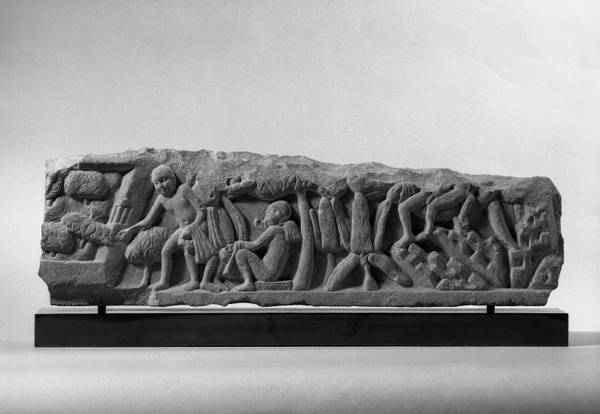
Nude monks carrying cloths
Image by Brooklyn Museum © CC-BY-NC
There is little clear evidence of this sect. With its origins and decline uncertain, it has a complicated history, which scholars have painstakingly begun to reconstruct. Even so, the meaning of yāpanīya is not fully clear. But it is apparent that it stresses the practice of restraint and has nothing to do with external appearance, as ‘śvetāmbara’ and ‘digambara’ do.
Yāpanīyas could have been active in the period of the mid-second century BCE to the third century CE. One item of possible evidence is the Mathurā votive tablets depicting monks wearing a piece of cloth on their forearms to hide their nudity. However, these mendicants could be Digambara monks trying to accommodate the feelings of non-Jains who are hostile towards public nudity.
There is inscriptional evidence of Yāpanīyas between the 5th and 15th centuries, mainly in Karnataka, where they seem to have had influence.
References in Jain texts also show that they were active in intellectual life during part of this period.
At least one author can be identified as having belonged to the Yāpanīyas. Writing in the ninth century, Ācārya Śakaṭāyana authored two works on major topics of dispute between the Digambaras and Śvetāmbaras. These are:
- Treatise on Women’s Emancipation – Strī-nirvāṇa-prakaraṇa (Jaini 1991)
- Treatise on Food Consumption by the Omniscient – Kevali-bhukti-prakaraṇa.
These texts show that their doctrinal position stood between Śvetāmbaras and Digambaras on key subjects of disagreement. For instance, Śakaṭāyana does not consider that nudity is a requirement for liberation and holds that women can be liberated. On these two matters, they seem to have been closer to the Śvetāmbara view.
The Yāpanīyas seem to have disappeared after the 15th century and merged with the Digambaras.
Reading
- ‘The A(ñ)calagaccha Viewed from Inside and from Outside’
Nalini Balbir - Jainism and Early Buddhism in the Indian Cultural Context: Essays in Honor of Padmanabh S. Jaini
edited by Olle Qvarnström
Asian Humanities Press; Fremont, California, USA; 2003
- ‘Naked Ascetics in Southern Digambar Jainism’
Michael Carrithers - Man (New Series)
volume 24: 2
Royal Anthropological Institute of Great Britain and Ireland; June 1989
- ‘The Śvetāmbara Mūrtipūjak Jain Mendicant’
John Cort - Man (New Series)
volume 29: 4
Royal Anthropological Institute of Great Britain and Ireland; 1991
- ‘A Tale of Two Cities: On the Origins of Digambar Sectarianism in North India’
John E. Cort - Multiple Histories: Culture and Society in the Study of Rajasthan
edited by Lawrence A. Babb, Varsha Joshi and Michael W. Meister
Rawat Publications; Jaipur, Rajasthan, India; 2002
- ‘A Fifteenth-Century Digambar Jain Mystic and his Followers: Tāraṇ Taraṇ Svāmī and the Tāraṇ Svāmi Panth’
John E. Cort - Studies in Jaina History and Culture: Disputes and Dialogues
edited by Peter Flügel
Routledge Advances in Jaina Studies series; volume 1
Routledge Curzon Press; London, UK; 2006
- History of Jaina Monachism from Inscriptions and Literature
Shantaram Bhalchandra Deo - Deccan College Dissertation series; volume 17
Deccan College Postgraduate and Research Institute; Pune, Maharashtra, India; 1956
- The Jains
Paul Dundas - Library of Religious Beliefs and Practices series; series editor John Hinnels and Ninian Smart; volume 14
Routledge Curzon Press; London, UK; 2002
- ‘Jainism without Monks?: The case of Kaḍuā Śāh’
Paul Dundas - Approaches to Jaina Studies: Philosophy, Logic, Rituals and Symbols
edited by N. K. Wagle and Olle Qvarnström
Centre for South Asian Studies, University of Toronto Press; Toronto, Canada; 1999
- The Jaina Path of Purification
Padmanabh S. Jaini - University of California Press; Berkeley, California USA; 1979
- Gender and Salvation: Jaina Debates on the Spiritual Liberation of Women
Padmanabh S. Jaini - University of California Press; Berkeley, California, USA; 1991
- Bhaṭṭāraka Sampradāya: A History of the Bhaṭtāraka Pīṭhas especially of Western India, Gujarat, Rajasthan and Madhya Pradesh
Vidyādhara P. Joharāpurakara - volume 8
Jīvarāja Jaina Granthamālā; Sholapur, Maharashtra, India; 1958
- ‘Rethinking Religious Authority: A Perspective on the Followers of Śrīmad Rājacandra’
Emma Salter - Studies in Jaina History and Culture: Disputes and Dialogues
edited by Peter Flügel
Routledge Advances in Jaina Studies series; volume 1
Routledge Curzon Press; London, UK; 2006
- ‘The Revival of the Digambara Muni Tradition in Karnataka during the Twentieth Century’
Sabine Scholz - The Jaina Heritage: Distinction, Decline and Resilience
edited by Julia A. B. Hegewald
South Asian and Comparative Studies Heidelberg series; volume 2
Samskriti; New Delhi, India; 2011
- The Unknown Pilgrims: The voice of the sādhvīs – the history, spirituality, and life of the Jaina women ascetics
N. Shāntā - translated by Mary Rogers
Sri Garib Dass Oriental series; volume 219
Sri Satguru Publications; New Delhi, India; 1997
- Historical Dictionary of Jainism
Kristi L. Wiley - Historical Dictionaries of Religions, Philosophies, and Movements series; series editor Jon Woronoff; volume 53
Scarecrow Press; Maryland, USA; 2004
- +
- aAbhavya
- aAbhinandana
- aAbhiṣeka
- aĀcāra
- aĀcārāṅga-sūtra
- aĀcārya
- aAchalbhrata
- aAḍhāī-dvīpa
- aAdharma
- aAdho-loka
- aAdhyayana
- aAdvaita Vedānta
- aĀgama
- aAghātīya
- aAghātīya-karman
- aAgnibhuti
- aAgra
- aĀhāra
- aAhiṃsā
- aAhimsa Day
- aAjita
- aAjīva
- aAkampit
- aĀkāśa
- aAkbar the Great
- aAkṣaya-tṛtīyā
- aAlauddin Khalji
- aAlbert Einstein
- aAllah
- aAlms
- aĀlocanā
- aAloka-ākāśa
- aAmāri
- aAmbikā or Kūṣmāṇḍinī
- aAnagāra
- aAnanta
- aAnarthadaṇḍa
- aAnaśana
- aAnekānta-vāda
- aAṅga
- aAniconism
- aAnojjā
- aAntarāla
- aAntarāya-karma
- aAṇu
- aAṇu-vrata
- aAnukampā
- aAnuprekṣā
- aAnusvāra
- aApabhraṃśa
- aAparigraha
- aAra
- aĀrambha
- aĀrambhaja
- aĀratī
- aArdhamāgadhī Prākrit
- aArhaṃ
- aArhat
- aArśana-āvaraṇīya-karma
- aĀrta-dhyāna
- aĀryikā
- aĀryikā Jñānamati
- aĀśātanā
- aĀścarya
- aAscetic
- aAsceticism
- aAshram
- aAspiration
- aĀsrava
- aAṣṭa-maṅgala
- aAṣṭāpada
- aAstikāya
- aAstrolabe
- aAsura
- aAtheism
- aAticāra
- aAtiśayakṣetra
- aAtithisaṃvibhāgavrata
- aĀtma-vāda
- aĀtman
- aAuṃ
- aAurangzeb
- aAuspicious
- aAusterity
- aAvadhāna
- aAvadhi-jñāna
- aĀvaraṇī-yakarman
- aAvasarpiṇī
- aAvatāra
- aAvidyā
- aAxiom
- aĀyāga-paṭa
- aĀyambil
- aĀyu-karma
- aĀyurveda
- bBabur
- bBāhubali
- bBaladeva
- bBālāvabodha
- bBandha
- bBasadi
- bBazaar
- bBhadrankarvijay
- bBhagavant
- bBhaktāmara-stotra
- bBhakti
- bBhale
- bBharata
- bBhāṣā
- bBhāṣya
- bBhaṭṭāraka
- bBhāva
- bBhāva-pūjā
- bBhāvanā
- bBhavana-vāsin
- bBhavya
- bBhavyatva
- bBhaya
- bBhoga-bhūmi
- bBhogopabhoga
- bBodhi
- bBollywood
- bBrahmā
- bBrahma-deva
- bBrahmacārī
- bBrāhmaṇa
- bBraj Bhāṣā
- bBright fortnight
- bBritish Raj
- bBuddha
- bBuddhi-sagar
- bBuddhism
- bBuddhist
- cCaitya
- cCaityavāsin
- cCakravartin
- cCakreśvarī
- cCāmara
- cCandanā
- cCandragupta
- cCandraprabha
- cCanon
- cCāritra
- cCāritramohanīya-karman
- cCarũrī
- cCaste
- cCaturvidha-saṅgha
- cCaturviṃśati-stava
- cCāturyāma
- cCE
- cCelibacy
- cCha
- cChadmastha
- cChastity
- cCheda-sūtra
- cChristian
- cChristianity
- cClergy
- cCloning
- cColophon
- cCommentary
- cConch
- cConfession
- cCongregation
- cConsecration
- cCosmology
- cCremation
- cCrore
- cCult
- cCūrṇi
- dDādā-guru
- dDalit
- dDāna
- dDaṇḍa
- dDark fortnight
- dDarśana
- dDarśanamohanī-yakarman
- dDaśa-lakṣaṇa-parvan
- dDeity
- dDelhi Sultanate
- dDerāsar
- dDeśāvakāśika-vrata
- dDetachment
- dDevanāgarī
- dDevānandā
- dDevarddhi-gani
- dDevotee
- dDhamal
- dDhanuṣ
- dDhāra
- dDharma
- dDharma-dhyāna
- dDharma-sāgara
- dDharmastikaya
- dDhātakīkhaṇḍa
- dDholak
- dDhyāna
- dDiaspora
- dDig-vrata
- dDigambara
- dDīkṣā
- dDisciple
- dDīvālī
- dDivya-dhvani
- dDNA
- dDoctrine
- dDogma
- dDonor
- dDoṣa
- dDravya
- dDravya-pūjā
- dDrone
- dDuṣamā
- dDuṣamā-duṣamā
- dDuṣamā-suṣamā
- dDveṣa
- dDvīpa
- eEast India Company
- eEightfold Path
- eEkānta-vāda
- eEkendriya
- eElder
- eElders
- eEschatology
- eEtc up to
- fFarmān
- fFast
- fFatehpur Sikri
- fFestival
- fFestschrift
- fFiruz Shah
- fFly-Whisks
- fFolio
- fFour Noble Truths
- gGaccha
- gGaṇa
- gGaṇadhara
- gGanadharavada
- gGaṇeśa
- gGaṇin
- gGarba
- gGarbha
- gGarbha-gṛha
- gGaruḍa
- gGati
- gGene
- gGenomics
- gGhātī-yakarman
- gGhātīya
- gGhaznavid
- gGhiyasuddin Tughlaq
- gGhurid
- gGloss
- gGotra-karma
- gGujarāt
- gGujarati
- gGuṇa
- gGuṇa-sthāna
- gGuṇa-vrata
- gGupti
- gGuru
- gGuruṇī
- hHagiography
- hHajj
- hHaṃsa
- hHaribhadra
- hHariṇaigameṣin
- hHasta
- hHeresy
- hHiṃsā
- hHindi
- hHindu
- hHinduism
- hHīravijaya
- hHoroscope
- hHrīṃ
- hHumayun
- hHymn
- iIconoclasm
- iIconography
- iIdol
- iIndian Independence
- iIndology
- iIndra
- iIndrabhūti Gautama
- iIndriya
- iInitiation
- iIntercession
- iInvocation
- iIQ
- iIslam
- iIslamicate
- iIṣṭadevatā
- iĪśvara
- jJagat
- jJahangir
- jJain
- jJaina Devanāgarī
- jJaina Śaurasenī
- jJaina-dharma
- jJainaśāsana
- jJainness
- jJaisalmer
- jJamāli
- jJambū-dvīpa
- jJames Burgess
- jJanma
- jJanma-kalyāṇa
- jJarā
- jJāti
- jJina
- jJina-āgama
- jJina-bhavana
- jJina-bimba
- jJina-mātā
- jJinacandra-sūri
- jJinadatta
- jJinaprabha
- jJīva
- jJñāna
- jJñāna-āvaraṇīya-karma
- jJñāna-āvarṇiya
- jJñānsundar
- jJyotiṣka
- kKāla
- kKālakācārya-kathā
- kKālidāsa
- kKalpa-sūtra
- kKalpa-vṛkṣa
- kKalyāṇaka
- kKalyanvijay
- kKamaṇḍalu
- kKamaṭha
- kKarma
- kKarma-bhūmi
- kKarma-grantha
- kKarma-prakṛti
- kKarma-vāda
- kKarmon
- kKarnataka
- kKaṣāya
- kKathā
- kKāvya
- kKāya
- kKāyotsarga
- kKeśa-loca
- kKetu
- kKevala-jñāna
- kKevalin
- kKhalji
- kKharatara-gaccha
- kKnowledge
- kKriyā
- kKriyā-vāda
- kKṛṣṇa
- kKṣamā-śramaṇa
- kKṣapakaśreṇi
- kKṣatriya
- kKṣullaka
- kKulakara
- kKundakunda
- kKunthu
- lLabdhi
- lLaity
- lLakh
- lLāñchana
- lLands of Action
- lLaukāntika
- lLavaṇa-samudra
- lLeśyā
- lLiṅga
- lLinguistics
- lLoka
- lLoka-ākāśa
- lLoka-puruṣa
- lLoka-vāda
- lLotus
- lLotus lake
- mMadhya-loka
- mMahā-videha
- mMahā-vrata
- mMahābhārata
- mMahāmastakābhiṣeka
- mMāhārāṣṭra
- mMāhārāṣṭrī Prākrit
- mMahattarā Yākinī
- mMahāvīr Jayantī
- mMahāvīra
- mMakāra
- mMakkhali Gośāla
- mMalli
- mMāna-stambha
- mManaḥ-paryāya-jñāna
- mMaṇḍala
- mMaṇḍapa
- mMandit
- mMaṅgala
- mMantra
- mMantras
- mManuṣya-loka
- mMarāṭhī
- mMārgaṇā
- mMartyr
- mMarudevī
- mMaṭha
- mMati-jñāna
- mMauryaputra
- mMecca
- mMendicant lineage
- mMetarya
- mMiracle
- mMithyādṛṣṭi
- mMohandas Gandhi
- mMohanīya-karma
- mMokṣa
- mMonastic order
- mMonasticism
- mMonk
- mMonotheism
- mMosque
- mMount Meru
- mMount Sammeta
- mMṛgāvatī
- mMughal
- mMuhammad
- mMuhammad bin Tughlaq
- mMuhpattī
- mMūla-sūtra
- mMūlaguṇa
- mMumbaī
- mMuni
- mMunisuvrata
- mMurad Bakhsh
- mMūrti-pūjaka
- mMuslim
- mMysticism
- nNābhi
- nNāga-kal
- nNāgapurīya Tapā-gaccha
- nNāgarī
- nNāma-karma
- nNamaskāra-mantra
- nNami
- nNandīśvara-dvīpa
- nNandivardhana
- nNandyāvarta
- nNāraka
- nNāraki
- nNasalisation
- nNātha
- nNavrātrī
- nNaya-vāda
- nNemi
- nNidāna
- nniggaṃthāṇa vā 2
- nniggaṃtho vā 2
- nNigoda
- nNihnava
- nNikṣepa
- nNirgrantha
- nNirjarā
- nNirvāṇa
- nNiryukti
- nNiṣidhi
- nNitya
- nNiyati
- nNo-kaṣāya
- nNudity
- nNun
- oOcean of milk
- oOmniscience
- oOrdination
- ppa°
- pPadmaprabha
- pPadmāsana
- pPadmāvatī
- pPādukā
- pPalanquin
- pPalette
- pPañca-muṣṭi
- pPāṇḍava
- pPaṇḍit
- pPandit Dalsukh D. Malvania
- pPandit Sukhlalji
- pPāṇipātra
- pPāpa
- pParamātman
- pParameṣṭhin
- pPāraṇā
- pParigraha
- pPariṇāma
- pParīṣaha
- pParokṣa
- pPārśva
- pPārśvanātha
- pParyāya
- pParyuṣaṇ
- pPaṭa
- pPatan
- pPātra
- pPenance
- pPersian
- pPhala
- pPhilology
- pPicchikā
- pPilgrimage
- pPīr
- pPolymath
- pPoṣadha
- pPossession
- pPothī
- pPrabhas
- pPradakṣiṇā
- pPradeśa
- pPrākāra
- pPrakīrṇaka-sūtra
- pPrākrit
- pPramāda
- pPramukhā
- pPrati-vāsudeva
- pPratikramaṇa
- pPratimā
- pPratiṣṭhā
- pPratyākhyāna
- pPratyakṣa
- pPravacana
- pPrāyaścitta
- pPrayer
- pPre-modern
- pPreach
- pPredestination
- pProtestant
- pProvenance
- pPudgala
- pPūjā
- pPujārī
- pPukharavara-dvīpa
- pPuṇya
- pPūrva
- pPuṣkara-dvīpa
- pPuṣpadanta
- pPyre
- qQur’an
- rRāga
- rRāhu
- rRainy season
- rRajasthan
- rRajasthani
- rRājimatī
- rRajoharaṇa
- rRajput
- rRāma
- rRāmāyaṇa
- rRangoli
- rRās-garbā
- rRasa
- rRathanemi
- rRatna-traya
- rRātri-bhojana
- rRaudra-dhyāna
- rRecto
- rRelic
- rRenunciation
- rRetroflex
- rRevatī
- %Ṛg-veda
- rRite
- rRosary
- %Ṛṣabha
- %Ṛṣabhanātha
- rRupee
- sSaciyā Mātā
- sSādhu
- sSādhvī
- sSāgāra
- sSaint
- sŚaivaism
- sŚaka-saṃvat
- sSallekhanā
- sŚalya
- sSamacatuṣṭha
- sSamādhimaraṇa
- sSamaṇi
- sSāmarambha
- sSamavasaraṇa
- sSāmāyika
- sSaṃbhava
- sSamiti
- sSaṃjñā
- sSaṃkalpaja
- sSaṃsāra
- sSamudghāta
- sSaṃvara
- sSaṃvega
- sSamyak-cāritra
- sSamyak-darśana
- sSamyak-jñāna
- sSamyaktva
- sSaṃyama
- sSanctuary
- sSandalwood
- sSaṇgha
- sSanskrit
- sSant
- sŚānti
- sSapta-bhaṅgi-naya
- sSārambha
- sSarasvatī
- sSarvajña
- sSāsan-devi
- sŚāsana-devatā
- sŚāstra
- %Ṣaṭ-jīvanikāya
- sSatī
- sSatīmātā
- sSatya
- sSchism
- sScribe
- sScripture
- sSect
- sSecularism
- sŚenāī
- sSermon
- sŚeṣavatī
- sSevā
- sSeven fields of donation
- sShah Jahan
- sShantidas Jhaveri
- sShrine
- sSiddha
- sSiddha-śilā
- sSiddhacakra or Navadevatā
- sSiddhānta
- sSiddhārtha
- sSiddhi
- sSikh
- sSikhism
- sŚikṣā-vrata
- sŚīla
- sSin
- sSindh
- sŚītala
- sŚiva
- sSkandha
- sSomanatha
- sŚraddhā
- sŚramaṇa
- sŚrāvaka
- sŚrāvakācāra
- sŚrāvikā
- sŚreyāṃsa
- sŚrī
- sŚrīvatsa
- sŚruta-jñāna
- sŚruta-pañcamī
- sSthānaka-vāsin
- sSthāpanācārya
- sSthāvara
- sSthavira
- sSthiti
- sStrīmukti
- sStūpa
- sSubcontinent
- sSudarshana
- sŚuddhi
- sSudharma
- sŚūdra
- sSufism
- sSukha
- sŚukla-dhyāna
- sSulasā
- sSultan
- sSumati
- sSundarśrī
- sSupārśva
- sSūri
- sSuṣamā
- sSuṣamā-duṣamā
- sSuṣamā-suṣamā
- sSūtra
- sSuyam me ausam! Tenam bhagavaya evamakkhayam
- sSvādhyāya
- sSvāhā
- sSvastika
- sŚvetāmbara
- sŚvetāmbara Terāpanthin
- sŚvetāmbaras
- sSwan
- sSyād-vāda
- tTabla
- tTantra
- tTapā-gaccha
- tTapas
- tTāraṇ Svāmī Panth
- tTattva
- tTattvārtha-sūtra
- tTemple
- tTemple-city
- tThe Enlightenment
- tTheology
- tThree worlds
- %Ṭīkā
- tTilaka
- tTīrtha
- tTīrthaṃkaranāma-karman
- tTīrthankara
- tTransliteration
- tTrasa
- tTrasa-nāḍī
- tTriśalā
- tTriṣaṣṭi-śalākā-puruṣa-caritra
- tTti bemi
- tTughlaq
- tTunk
- uUdumbara
- uUniversal History
- uUpādhyāya
- uUpāṅga
- uUpaniṣads
- uUpāsaka
- uUpasarga
- uUpāśraya
- uŪrdhva-loka
- uUtsarpiṇī
- uUttarādhyayana-sūtra
- vVāhana
- vVaimānika
- vVairāgya
- vVaiṣṇava
- vVaiśramaṇa
- vVaiśya
- vValabhī
- vVanaspatikāya
- vVandana
- vVaṇik
- vVarṇa
- vVāsudeva
- vVāsupūjya
- vVayubhūti
- vVeda
- vVedanīya-karma
- vVegetarianism
- vVehicle
- vVernacular
- vVerso
- vVidyā
- vVidyā-devī
- vVihāra
- vVijñapti-patra
- vVikrama-saṃvat
- vVikṛti
- vVimala
- vVinaya
- vVipāka
- vVirji Vora
- vVirodhaja
- vVīrya
- vVisarga
- vViṣṇu
- vVītarāga
- vVizier
- vVotive
- vVow
- vVrata
- vVS
- vVyakta
- vVyantara
- vVyasana
- yYakṣa
- yYakṣī
- yYantra
- yYaśoda
- yYaśovijaya
- yYati
- yYātrā
- yYoga
- yYoginī
- yYojana




